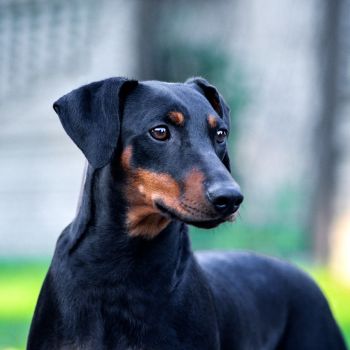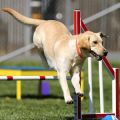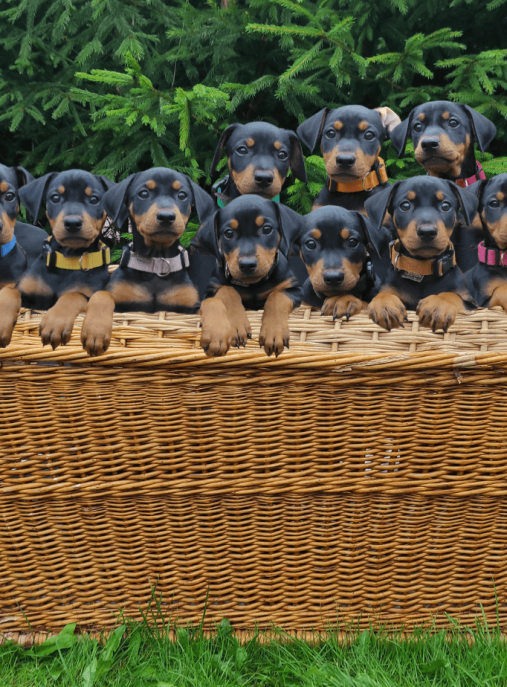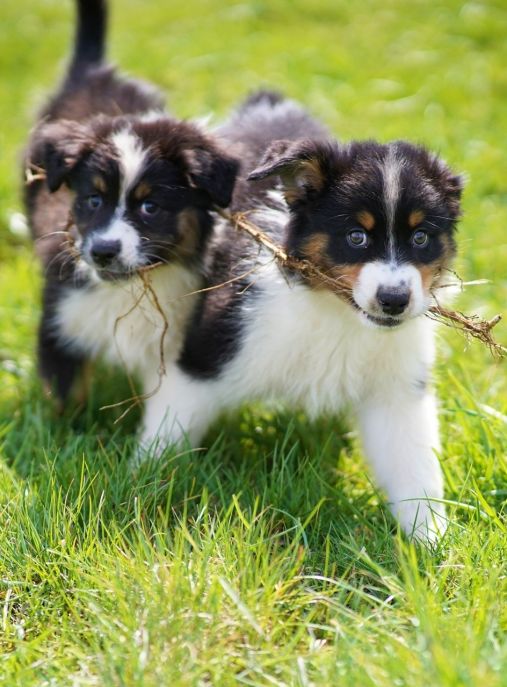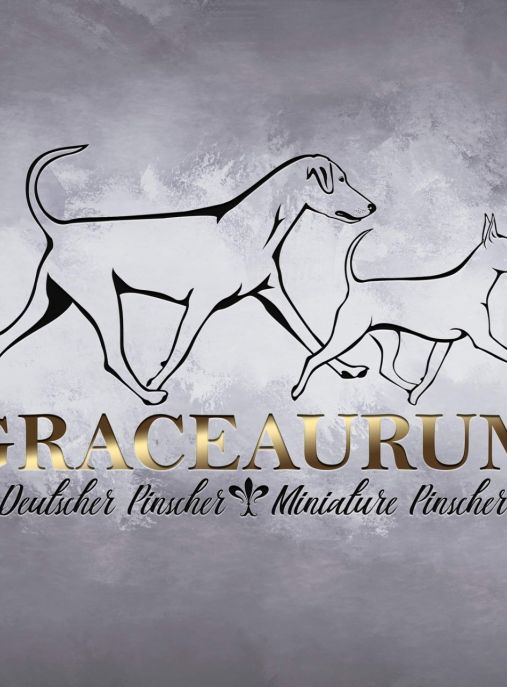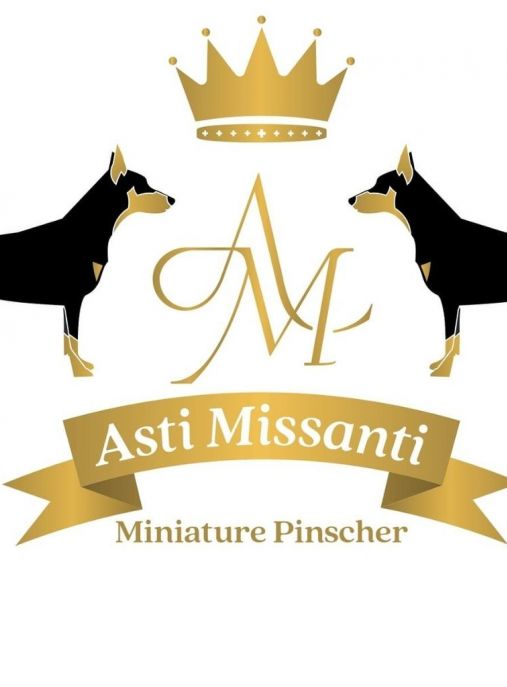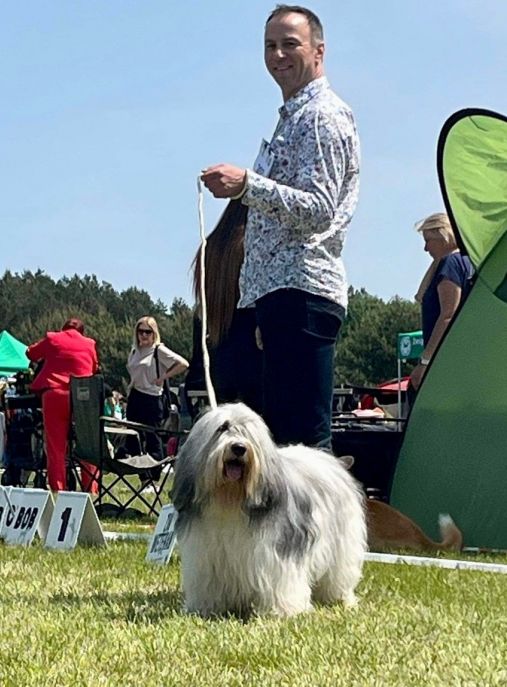The German Pinscher is a medium-sized dog breed known for its elegance, intelligence, and spirited nature. With a well-muscled body and a sleek, short coat, these dogs possess a distinct appearance that sets them apart from other breeds. They are often referred to as the "little devil" due to their mischievous and lively nature. German Pinschers are versatile dogs that excel in various activities, including obedience, agility, and even as family companions.
The history of the German Pinscher dates back to the 15th century in Germany. They were initially bred as farm dogs, primarily used for guarding properties, catching vermin, and herding livestock. Over time, their role expanded to include guarding horse-drawn carriages and acting as reliable watchdogs. The breed faced near extinction during World War II, but dedicated breeders managed to revive the German Pinscher, ensuring its survival and continued popularity.
According to the Fédération Cynologique Internationale (FCI) typology, the German Pinscher belongs to Group 2: Pinscher and Schnauzer type, Molossian type, and Swiss Mountain and Cattle Dogs. Within this group, they are classified under Section 1: Pinscher and Schnauzer type. This classification highlights their close relation to other breeds like the Doberman Pinscher, Miniature Pinscher, and the Schnauzer.
German Pinschers are known for their loyalty and affection towards their families. They form strong bonds with their owners and are highly protective of them. While they are generally good with children, early socialization and training are essential to ensure they understand appropriate behavior around kids. Due to their high energy levels and need for mental stimulation, they are best suited for active individuals or families who can provide them with regular exercise and mental challenges.
In terms of physical characteristics, the German Pinscher stands at an average height of 17 to 20 inches (43 to 51 cm) at the shoulder. They have a well-proportioned body with a deep chest and a strong, muscular build. The breed typically weighs between 25 to 45 pounds (11 to 20 kg), with males being slightly larger than females. Their short, dense coat comes in various colors, including black, red, fawn, and blue with tan markings.
The average lifespan of a German Pinscher is around 12 to 14 years, which is relatively long for a medium-sized breed. However, like any dog, their lifespan can be influenced by factors such as genetics, diet, exercise, and overall healthcare. Regular veterinary check-ups, a balanced diet, and an active lifestyle can contribute to their longevity.
One interesting fact about German Pinschers is their exceptional intelligence. They are quick learners and thrive on mental stimulation. This intelligence, combined with their natural curiosity, makes them highly trainable. However, they can also be independent and strong-willed, requiring consistent and firm training methods. Positive reinforcement techniques, such as treats and praise, work best with this breed.
Another notable characteristic of German Pinschers is their strong prey drive. They have a natural instinct to chase small animals, which can make them unsuitable for households with small pets like rabbits or guinea pigs. Early socialization and training can help mitigate this instinct, but it is important to supervise them around smaller animals.
In conclusion, the German Pinscher is a versatile and spirited breed with a rich history. Their intelligence, loyalty, and protective nature make them excellent companions for active individuals or families. With proper training, socialization, and care, these dogs can thrive in various activities and provide endless love and joy to their owners.
The German Pinscher is a breed of dog known for its spirited and lively character. With their sleek and elegant appearance, these dogs possess a unique combination of intelligence, loyalty, and independence. German Pinschers are highly energetic and require an active lifestyle to keep them mentally and physically stimulated.
In terms of behavior, German Pinschers are known to be confident and fearless. They have a strong prey drive and may exhibit a high level of alertness, making them excellent watchdogs. These dogs are naturally protective of their families and can be wary of strangers, making them great guard dogs as well.
When it comes to raising and training a German Pinscher, it is essential to establish a firm and consistent approach. These dogs are intelligent and quick learners, but they can also be stubborn at times. Early socialization and obedience training are crucial to ensure they grow up to be well-rounded and well-behaved companions.
German Pinschers thrive in an environment where they have a clear leader and a structured routine. Positive reinforcement techniques, such as rewards and praise, work best with this breed. Harsh training methods or excessive force can lead to resistance and may damage the bond between the dog and its owner.
Exercise is a vital aspect of raising a German Pinscher. These dogs have a high energy level and require regular physical activity to prevent boredom and destructive behavior. Daily walks, runs, or play sessions in a securely fenced yard are necessary to keep them mentally and physically stimulated. Engaging them in activities like agility, obedience, or scent work can also provide an outlet for their energy and intelligence.
While German Pinschers are generally good with children, it is important to supervise their interactions, especially with younger kids. Their high energy levels and strong prey drive may make them too boisterous for small children. Early socialization with other animals is also crucial to ensure they get along well with other pets in the household.
Grooming a German Pinscher is relatively low maintenance. Their short, dense coat requires regular brushing to keep it clean and free from loose hair. They shed moderately throughout the year, with a heavier shedding period during seasonal changes. Regular nail trims, teeth brushing, and ear cleaning should also be a part of their grooming routine.
In summary, German Pinschers are spirited and lively dogs with a confident and fearless character. They require an active lifestyle, consistent training, and early socialization to thrive. With the right approach, these intelligent and loyal dogs can make excellent companions and devoted family members.
The German Pinscher is a medium-sized, energetic, and intelligent breed known for its loyalty and protective nature. To ensure the well-being and happiness of your German Pinscher, it is essential to provide them with proper care and attention. Here is an extensive description of the recommended care for German Pinscher dogs, along with tips on what to do and what not to do:
1. Exercise: German Pinschers are an active breed that requires regular exercise to maintain their physical and mental health. Aim for at least 60-90 minutes of exercise daily, including brisk walks, jogging, or playtime in a securely fenced yard. Engaging them in mentally stimulating activities like obedience training or agility courses is also beneficial.
2. Mental Stimulation: German Pinschers are highly intelligent dogs that thrive on mental challenges. Provide them with interactive toys, puzzle games, and obedience training sessions to keep their minds engaged. Failure to provide adequate mental stimulation may lead to boredom and destructive behavior.
3. Socialization: Early and ongoing socialization is crucial for German Pinschers. Introduce them to various people, animals, and environments from a young age to help them develop into well-rounded and confident dogs. Enroll them in puppy classes or socialization groups to expose them to different situations and ensure they grow up to be friendly and well-behaved.
4. Training: German Pinschers are intelligent and eager to please, making them highly trainable. Start obedience training early, using positive reinforcement techniques such as treats, praise, and play. Consistency, patience, and firmness are key to successful training. Avoid harsh training methods or punishment, as it can lead to fear or aggression.
5. Grooming: The German Pinscher has a short, dense coat that requires minimal grooming. Brush their coat once a week to remove loose hair and keep it looking neat. Regularly check their ears for signs of infection and clean them as needed. Trim their nails regularly and brush their teeth at least two to three times a week to maintain good oral hygiene.
6. Health Care: Regular veterinary check-ups are essential to ensure your German Pinscher's overall health. Vaccinations, parasite prevention, and dental care should be part of their routine healthcare. German Pinschers are generally healthy dogs, but they may be prone to certain genetic conditions such as hip dysplasia, von Willebrand's disease, or cardiac issues. Responsible breeders conduct health screenings before breeding to minimize the risk of these conditions.
7. Diet: Provide your German Pinscher with a balanced and nutritious diet appropriate for their age, size, and activity level. Feed them high-quality dog food that contains real meat as the primary ingredient. Avoid overfeeding and monitor their weight to prevent obesity, which can lead to various health problems.
8. Safety: German Pinschers are known for their protective instincts, so it is crucial to ensure their safety. Secure your yard with a sturdy fence to prevent them from escaping. Keep them on a leash during walks to avoid potential confrontations with other dogs or animals. Be cautious when introducing them to new people or situations, as they may be wary of strangers.
9. Companionship: German Pinschers are highly social dogs that thrive on human companionship. They are not suited for long periods of isolation or being left alone for extended periods. Ensure they have plenty of quality time with their family and avoid leaving them alone for more than a few hours. Consider providing them with interactive toys or a companion dog if you cannot be with them throughout the day.
10. Love and Affection: German Pinschers are loyal and loving dogs that form strong bonds with their owners. Show them love, affection, and praise to reinforce their positive behavior. Spend quality time with them, provide them with a comfortable sleeping area, and make them feel like a valued member of your family.
Remember, each German Pinscher is an individual, and their care may vary slightly. By following these general guidelines and tailoring them to your dog's specific needs, you can ensure a happy, healthy, and well-adjusted German Pinscher companion.
The German Pinscher is a breed known for its striking and distinctive coat color. The most common color seen in German Pinschers is a rich shade of solid black or a deep shade of red. These colors are often referred to as "black and tan" or "red and tan" respectively.
In the case of the black and tan German Pinscher, the majority of the body is covered in a glossy black coat. This black color is usually deep and intense, giving the dog a sleek and elegant appearance. The tan markings are typically found on specific areas of the body, including the eyebrows, cheeks, muzzle, chest, legs, and under the tail. These tan markings are usually a warm, reddish-brown color, which creates a beautiful contrast against the black coat.
The red and tan German Pinscher, on the other hand, showcases a stunning coat that is predominantly a rich shade of red. This red color can vary in intensity, ranging from a deep mahogany to a vibrant and fiery red. Similar to the black and tan variety, the tan markings are present on specific areas of the body, such as the eyebrows, cheeks, muzzle, chest, legs, and under the tail. The tan markings in this color variation are usually a lighter shade of red or a warm tan color, complementing the overall appearance of the dog.
Regardless of the color variation, German Pinschers have a short and dense coat that lies close to their body. This coat texture not only enhances their sleek and athletic appearance but also provides them with protection against various weather conditions. The coat is known for its natural shine, which adds to the overall allure of the breed.
It is important to note that while black and tan and red and tan are the most common colors seen in German Pinschers, there are also other color variations that can occur. These include solid black, solid red, and even blue and tan. However, these variations are less common and not as widely recognized as the black and tan and red and tan colors.
In conclusion, the German Pinscher is a breed that exhibits a striking and eye-catching coat color. Whether it is the deep and intense black and tan or the rich and vibrant red and tan, the color variations of this breed are sure to captivate anyone's attention. With their sleek and glossy coats, German Pinschers truly stand out in the canine world.
The German Pinscher is a robust and energetic breed known for its athleticism, intelligence, and loyalty. When it comes to their health, German Pinschers are generally considered to be a relatively healthy breed. However, like all dogs, they are still prone to certain health conditions. Understanding these common diseases and taking appropriate care can help ensure the well-being of your German Pinscher.
One of the most prevalent health issues in German Pinschers is hip dysplasia. This condition occurs when the hip joint doesn't develop properly, leading to discomfort, lameness, and arthritis. Regular exercise on soft surfaces, maintaining a healthy weight, and avoiding excessive jumping can help reduce the risk of hip dysplasia. Additionally, responsible breeders perform hip evaluations on their breeding dogs to minimize the occurrence of this condition.
Another common health concern in German Pinschers is progressive retinal atrophy (PRA). PRA is a degenerative eye disease that leads to gradual vision loss and, in severe cases, blindness. Regular eye examinations by a veterinary ophthalmologist can help detect PRA early on, allowing for appropriate management and lifestyle adjustments to accommodate the dog's visual impairment.
Von Willebrand's disease (VWD) is a hereditary bleeding disorder found in German Pinschers. Dogs with VWD have a deficiency or dysfunction of a specific clotting protein, which can result in excessive bleeding or prolonged bleeding after injuries or surgeries. Genetic testing is available to identify carriers and affected dogs, allowing responsible breeders to make informed breeding decisions. If your German Pinscher is diagnosed with VWD, your veterinarian can provide guidance on managing the condition and minimizing the risk of bleeding episodes.
Like many other breeds, German Pinschers can also be prone to certain types of cancer, such as hemangiosarcoma and osteosarcoma. Regular veterinary check-ups, early detection, and prompt treatment are crucial in managing these conditions. Additionally, maintaining a healthy diet, providing regular exercise, and minimizing exposure to environmental toxins can help reduce the risk of cancer.
To ensure the overall health of your German Pinscher, it is essential to provide them with a balanced diet that meets their nutritional needs. Regular exercise is also crucial to keep them physically and mentally stimulated. Mental enrichment, such as puzzle toys and training sessions, can help prevent boredom and destructive behaviors.
Routine veterinary care, including vaccinations, parasite prevention, and dental care, is vital for maintaining your German Pinscher's health. Regular check-ups allow your veterinarian to detect any potential health issues early on and provide appropriate treatment.
Lastly, it is essential to provide your German Pinscher with a safe and stimulating environment. This includes a secure and well-fenced yard to prevent accidents or escapes. Regular grooming, including brushing their short coat and cleaning their ears, helps maintain their hygiene and prevents skin issues.
In conclusion, while German Pinschers are generally healthy dogs, they can still be susceptible to certain health conditions. Regular veterinary care, responsible breeding practices, and a well-balanced lifestyle can help ensure the overall health and well-being of your German Pinscher. By being proactive and attentive to their needs, you can enjoy many happy and healthy years with your beloved companion.
The German Pinscher is a medium-sized breed known for its intelligence, agility, and loyalty. To ensure their overall health and well-being, it is crucial to provide them with a balanced and nutritious diet. Proper nutrition plays a vital role in maintaining their energy levels, promoting healthy growth, and preventing common health issues. In this text, we will discuss the nutritional needs of German Pinschers, provide advice on feeding them, and highlight foods to avoid.
German Pinschers require a diet that is rich in high-quality proteins, healthy fats, and essential vitamins and minerals. Proteins are essential for muscle development and repair, and they should make up a significant portion of their diet. Good sources of protein for German Pinschers include lean meats like chicken, turkey, and beef, as well as fish and eggs. It is important to ensure that the proteins are cooked thoroughly to eliminate any potential bacteria or parasites.
Healthy fats are also crucial for German Pinschers as they provide a concentrated source of energy. Fats aid in the absorption of fat-soluble vitamins and help maintain healthy skin and coat. Incorporating healthy fats like fish oil, flaxseed oil, and olive oil into their diet can be beneficial. However, it is important to remember that fats should be given in moderation to prevent weight gain and obesity.
Carbohydrates are another essential component of a German Pinscher's diet. They provide a source of energy and fiber, aiding in digestion. Opt for complex carbohydrates like whole grains (brown rice, oats) and vegetables (sweet potatoes, carrots) rather than simple carbohydrates like white rice or refined grains. Complex carbohydrates provide sustained energy and are less likely to cause spikes in blood sugar levels.
German Pinschers should also have a diet rich in vitamins and minerals. Fresh fruits and vegetables are excellent sources of essential vitamins and antioxidants. Some safe options include apples, blueberries, broccoli, and spinach. However, it is important to avoid feeding them grapes, raisins, onions, garlic, and avocados, as these can be toxic to dogs.
When it comes to feeding schedules, German Pinschers generally do well with two meals a day. Puppies may require more frequent feeding to support their growth. It is important to measure the portions according to their age, weight, and activity level. Overfeeding can lead to obesity, which can have detrimental effects on their overall health.
In addition to a balanced diet, fresh and clean water should always be available for German Pinschers. Hydration is crucial for their overall well-being and aids in digestion, temperature regulation, and nutrient absorption.
While it is essential to provide a nutritious diet, it is equally important to avoid certain foods that can be harmful to German Pinschers. Some common foods to avoid include chocolate, caffeine, alcohol, fatty foods, sugary treats, and foods containing artificial sweeteners like xylitol. These can cause various health issues ranging from gastrointestinal upset to organ damage.
In conclusion, German Pinschers require a balanced and nutritious diet to thrive. A diet rich in high-quality proteins, healthy fats, complex carbohydrates, vitamins, and minerals is essential for their overall health and well-being. Feeding them in appropriate portions, avoiding harmful foods, and providing fresh water will help ensure a long and healthy life for your German Pinscher.

